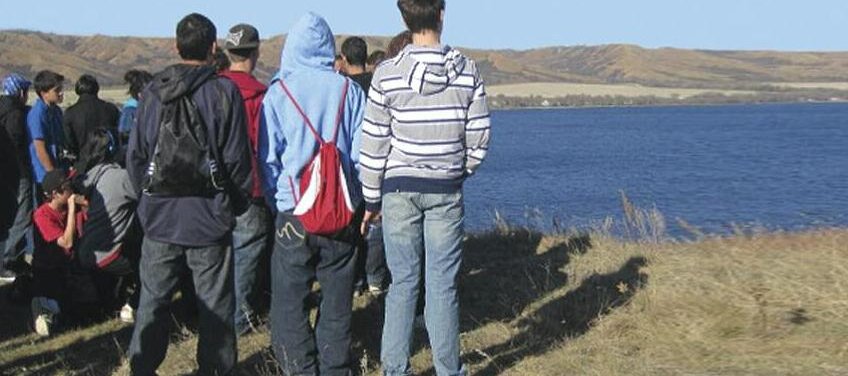
Partners for creative Treaty Education
Related Programs
Cultural Areas
First Nations
Students in The Prairie Valley School Division explored their relationship to the land and to the Treaties through a Creative Partnership that had them interviewing community members, visiting outdoor sites and learning about digital film-making.
“We were looking for an opportunity to connect the many schools in the area, which includes both First Nations and provincial schools,” explains Sandy Pinay- Schindler, an educator with the Prairie Valley School Division (PVSD). “We wanted to explore the idea of learning about Saskatchewan history, First Nations culture, settlers and the growth of this province, as part of Treaty education.”
The School Division received a Creative Partnerships explorations Grant that enabled them to form a partnership with a Saskatchewan artist in order to collaboratively explore, assess and plan a learning opportunity based on one of the essential Learnings in the Treaty education curriculum. The explorations Grant is the first step for any group interested in receiving a Creative Partnerships Innovations Grant that can be used to hire an artist to work on a longer-term partnership project.
“Through our exploration we decided to work on determining what, as Treaty people, was our relationship to the land,” explains Pinay-Schindler. Teachers worked together to create the lesson plans and worked with Saskatchewan artist Lesley Farley to create a learning opportunity that would incorporate digital photography, video, audio and storytelling from community members. upon receiving the Innovations Grant, the Division was able to engage 200 Grade 10 students from eight schools in the Fort Qu’Appelle, Indian Head and Crooked Lake areas, which included three First Nations schools, in a project where they visited each others communities and explored the different connections people had with the land.
One group of students had an opportunity to visit a fourth generation farm during harvest season and listened to local farmer manuel miller share his experience with the land. “many students hadn’t had the opportunity to visit a farm before,” says Pinay-Schindler, “it was an opportunity to hear a different perspective.” Others travelled to Standing Buffalo reserve to visit with a band that didn’t sign Treaty 4 and hear a different perspective. Their tours included Treaty 4 Governance Centre, heritage buildings such as Hudson Bay Co., and other monuments.
Another group of students met with elder Sam Isaac, from the Ochapowace First Nations. “He stood on the edge of a hill above Round Lake and pointed out areas of significant meaning to the students, such as the location of winter camps, where he was born, the meaning of the lake, how the land sustained the people,” explains Pinay-Schindler. “He shared stories about Chief Kakisiwew and Cree teachings of respect for animals, plants, and all living things. His teachings were riveting for students. He explained how human beings depend on everything else to survive.”
“The experience was very positive for the students and for the community,” she says. “The students appreciated how willing community members were to share their views on the Treaties and their personal stories about their relationship to the land.”
After visiting different locations and reviewing the stills, footage and audio they had collected, the students learned how to compile the most meaningful work into documentary films. In total, 12 films were created, along with a bonus film by artist Lesley Farley, and were screened at a special gala event held this past June.
“The learning process, the community visits and the films have created a lasting legacy for the school,” adds Pinay- Schindler. Although not yet ready for public viewing (copies of the DVD were given to all participating students, community members, elders, and teachers, and copies were given to all of the Treaty 4 and PVSD schools for their Treaty kits), the films will become part of ongoing Treaty education in the Prairie Valley School Division.
Creative Partnerships is a grant program offered by the Saskatchewan Arts Board in partnership with SaskCulture with funding from Saskatchewan Lotteries Trust Fund for Sport, Culture and Recreation. The program provides communities, businesses, schools and other organizations a range of opportunities to partner with artists and tap the creativity of the province.

